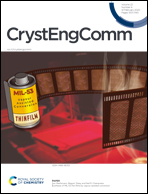Bis-Dithiocarbamates derived from 1,10-diaza-18-crown-6 as ligand tectons for 1D, 2D and 3D supramolecular structure arrangements†
Abstract
The reaction of 1,10-diaza-18-crown-6 (= aza-crown) with an excess of carbon disulfide in the presence and absence of a base (MOH or NEt3 with M = Li, Na, K, Rb and Cs) gave eight bis-dithiocarbamate (bisdtc) salts of compositions [Li2(aza-crown-bisdtc)]·5H2O (1), [Na2(aza-crown-bisdtc)]·3H2O (2), [K2(aza-crown-bisdtc)(MeOH)3] (3), [Rb2(aza-crown-bisdtc)(MeOH)2] (4), [Cs2(aza-crown-bisdtc)(MeOH)2] (5), [Rb2(aza-crown-bisdtc)(aza-crown)] (6), [(HNEt3)2(aza-crown-bisdtc)] (7), and [(H2aza-crown)(aza-crown-bisdtc)]·2H2O (8), which were characterized as far as possible by spectroscopic methods, mass spectrometry and single-crystal X-ray diffraction (SCXRD) analysis. The SCXRD studies of the alkali metal salts 3–6 revealed five different coordination modes of the dtc ligands towards the metal center, which are generally coordinated to at least one metal atom in the anisobidentate mode and involved in di-, tri- or tetranuclear M–S–M bridging. The coordination numbers for the metal ions vary from seven to ten with the participation of oxygen atoms from the crown ether and from solvent molecules (MeOH), the sulfur atoms or all atoms of the dtc groups and in one case a nitrogen atom from a neutral aza-crown. The coordination geometries are significantly distorted from ideal regular polyhedra, which is attributed to the presence of extensive bridging through the metal-coordinated oxygen and sulfur atoms as well as the small bite angle of the dtc groups. The supramolecular analysis of the alkali metal salts showed the formation of either a tetranuclear metal cluster or a 1D strand through M–OMeOH–M, M–Ocrown-ether–M and M–Sdtc–M bridging, which in three of the four salts resulted in 2D or 3D coordination polymers due to further linkage by the aza-crown ligands. In the crystal structure of the alkali metal salt 3 and the ammonium salts 7 and 8, hydrogen bond formation is observed involving strong charge-assisted O–H⋯−Sdtc, N+–H⋯O and N+–H⋯−Sdtc interactions as well as weaker Ow–H⋯O and C–H⋯O/S interactions. The thermogravimetric analysis of the alkaline derivatives 3–5 showed good thermal stability, with a decomposition point of around 250 °C.



 Please wait while we load your content...
Please wait while we load your content...